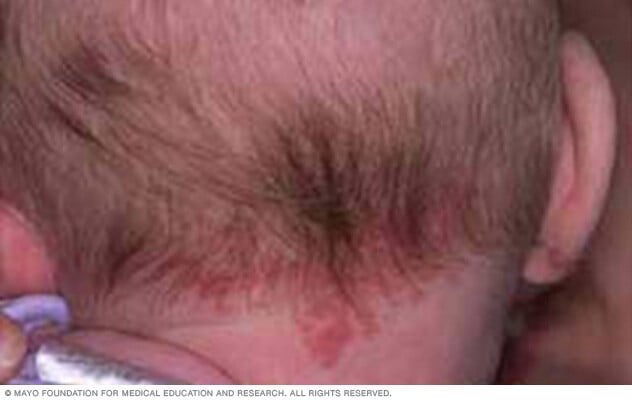Birthmarks
Birthmarks are areas of skin that differ from the surrounding skin. Types include café au lait spot, congenital nevus and hemangioma. Not all birthmarks are present at birth — some develop weeks later.
Birthmarks are usually harmless and don't need treatment. Some fade with time. People may seek treatment for cosmetic reasons or because the birthmark is painful, large or fast growing. Some birthmarks may be a sign of an underlying disease.
Cafe au lait spot

Cafe au lait (ka-FAY o lay) spots are flat oval or round patches. They range in color from tan to dark brown. They are permanent and very common. They can occur anywhere on the body, and the size increases as the child grows. Usually, no treatment is needed.
Children may have one or several cafe au lait spots. Having several spots may be a sign of a genetic condition, such as neurofibromatosis. Or it may be a sign of some other serious condition. Talk with a healthcare professional about whether your child needs a medical exam with a doctor who specializes in skin conditions. This type of doctor is a dermatologist.
Congenital nevus

Usually present at birth, a congenital nevus is a painless, dark-colored mole that often appears on the scalp or trunk of the body. It can range in size from a couple of millimeters to several centimeters in diameter. Sometimes, hair grows within the birthmark.
Children with a congenital nevus may be at an increased risk of developing skin cancer as adults. This is especially true for those with a large nevus. If your child has this type of birthmark, talk with a healthcare professional about watching for changes in the skin. Treatment may be considered depending on the size, location and risk of skin cancer.
Slate gray nevus

A slate gray nevus is a usually harmless, large flat patch. It may show up on the lower back, buttocks or shoulders. And the color ranges from deep brown to slate gray or blue-black. It can be mistaken for a bruise. This type of birthmark is more common in Black, Native-American, Hispanic and Asian babies than in white babies. A slate gray nevus tends to fade during early childhood and needs no treatment.
It's also called a congenital dermal melanocytosis and was formerly called a Mongolian spot.
Port-wine stain on the cheek

Port-wine stain on the trunk

A port-wine stain is a permanent birthmark present from birth. Color ranges from pink or light brown to deep maroon. It grows as the child grows. Most often, a port-wine stain appears on the face, but it can affect other areas. In adulthood, the involved skin may become thicker and darker.
Port-wine stains may cause medical problems and emotional stress. Early laser therapy is the usual treatment. Sometimes port-wine stains occur with Klippel-Trenaunay syndrome or Sturge-Weber syndrome, which requires regular medical evaluation.
Salmon patches (stork bites)

Salmon patches are small areas of skin that are darker than the surrounding skin. They're often found above the hairline at the back of the neck, on the eyelids or between the eyes. These marks are caused by collections of capillary blood vessels close to the skin. This type of birthmark is also called a stork bite, an angel kiss and a nevus simplex.
Salmon patches may fade as the child grows, though patches at the nape of the neck may be permanent. Salmon patches don't need to be treated.
Hemangioma below an ear

Hemangioma behind an ear

A hemangioma is a common blue, purple or red birthmark. It may be present at birth, or it may appear and grow during the first few months after birth. It tends to be on the head or neck. This type of birthmark tends to get smaller with time. By age 10, a child who had a hemangioma in infancy may retain only a mark of the growth. These birthmarks also are called infantile hemangiomas.
Hemangiomas don't always need to be treated. Your doctor may suggest medicine or laser treatments for a hemangioma that is fast growing or threatens some aspect of a child's form or ability to function. If your child has more than one hemangioma, your doctor may want to check whether your child has internal hemangiomas.
Seek medical attention for hemangiomas that:
- Are large.
- Are present along the midline of the body.
- Involve an entire segment of the skin.
Hemangiomas like this can be a sign of internal organ structure changes.



